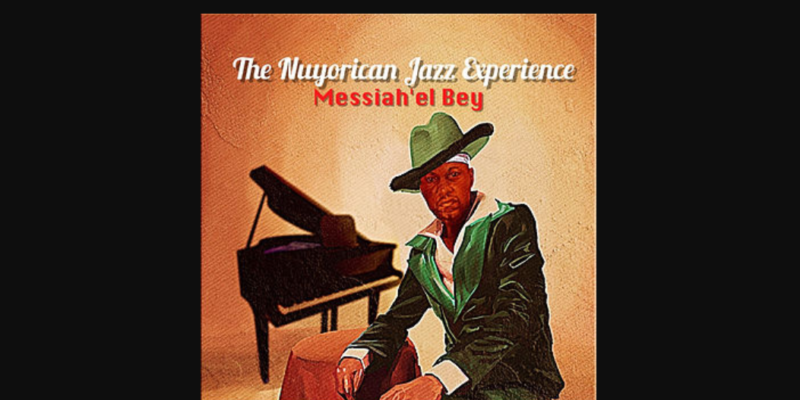‘…the composer doesn’t make the music, but the music finds the composer,’ says cousin Jeanine Morales in one of the answerphone message snippets that have been edited together to float over the opening cut here, Hear Me (intro).
It’s a fascinating piece of advice that feels absolutely prevalent to the whole project.
When, as a reviewer, you’re confronted by a body of work that’s so clearly got a great story behind it, you want to sink your fingers into the back story to find out where on earth it came from.
Digging around on the internet revealed that Bey has a pedigree in different musical genres that are not obvious upon listening to The Nuyorican Jazz Experience. Though, if you are listening through without that knowledge, it’s rapidly obvious that there’s a mix of organic and digital instruments and styles that is genuinely beguiling.
The opening track, Hear Me (intro) doesn’t give too much away, as it’s pretty straightforward (relatively) listening. There are some cool, deft, laid-back musings on guitar poking through occasionally, while a muted trumpet wails and flutters in the background. The main thrust of the track is the walking bass line and traditional jazz drum kit, holding down the groove. The messages, all enquiring around the album that you are listening to, provide a self-mythologizing narrative that’s compelling – perfectly setting up what you’re about to listen to. Talk about a smart intro!
Ay Dios Mio is a merciless mission statement though. Its contrary melodic lines jockey for supremacy in a flurry of brass instruments and piano lines, while a relentless, shuffling rhythm section drives the whole through. On the brass front, there are solo voices and other phrases played in harmony. About three-quarters of the way through, the discordant battle-storm breaks, a new bass line takes centre stage, an audience applauds and our composer welcomes us to the show, thanking us for our love and support. He’s whooped and clapped to the track’s conclusion, and we’re into When El Barrio Was Called Home.
A less challenging track, though still wearing its jazz credentials boldly on its sleeve, When El Barrio Was Called Home continues to feature solo trumpet, mysterious-sounding piano lines and haunting synth vocal pads. An organic-sounding kit keeps a loose yet utterly groovy handle on the rhythm as bass sometimes underpins it, and sometimes doesn’t – allowing the capture of the kit to shine through. These are bold, unexpected and unconventional production choices (especially if you’re not used to listening to jazz works) that are sonically fascinating and keep you listening.
A more contemporary heartbeat runs through Nuyorican Lady, detuned instruments competing with digital guitar and heavily processed instruments creating a tapestry of sound that puts me in mind of the work of Imogen Heap.
Purple Sunshine (Ode to Prince) is up next. Another complex and skittering drum part that has huge character locks down the progress of this track which features a prominent saxophone. As it concludes, a female voice declares, ‘Feel the fury of the cosmos, mortal…’
A word here about how to approach listening to this kind of material. As it’s melodically challenging and properly complex, some people can be put off by the explorations undertaken by jazz music. I used to worry it was a lack of intelligence or musicality on my part that found this kind of work difficult to digest. But then a virtuoso bass-playing friend of mine, well versed in this kind of fare, took me to a John Patitucci gig. Noticing me looking perplexed and uncomfortable, he leaned over and said, gently, ‘Relax… it’s all about where it takes you’.
So where do you want to go?
Symphony of the Proud Garifuna features marimbas, noodling sine wave synth, synth strings and a muscular house beat – that then morphs into new and discordant territories about two-thirds of the way through. It’s a musical journey in every regard.
Up next is Bennettsville Electra. I’m suddenly thrown back to the more obscure instrumental album tracks of Life In Mono by Mono. Another schizophrenic piece that changes its DNA halfway through, Bennettsville Electra becomes an exploration of rhythm, harmony and melody on piano. Congas and guitars drive, while punctuation comes from bass. An unexpected ending delivers us into Too Much Sangria Is Never Enough Ayanna.
This concluding track is bass-heavy, featuring a mash-up of styles, perhaps best bringing together Bey’s own ancestry and influences, which (according to his website) include ‘the Garifuna along with African American, Latin American, and some European nobility’.
This isn’t wallpaper or elevator music – you are going to have to sit down and listen. And you’ll be rewarded with a unique listening experience sans vocals. These pieces feel like musical conversation between different groups of musical voices. Hats off to the mixing, which retains enough separation to keep the dialogue clear.
Visit Messiah’el Bey’s Website or Warlock Asylum for more information.

